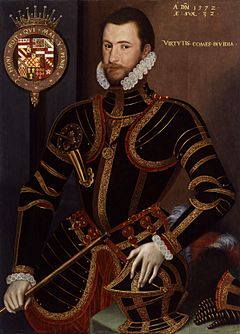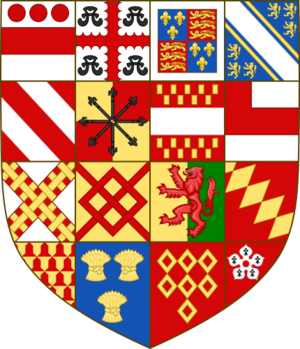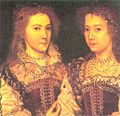Walter Devereux, 1st Earl of Essex facts for kids
Quick facts for kids
The 1st Earl of Essex
|
|
|---|---|

Walter Devereux, 1st Earl of Essex, as Earl Marshal of England, 1575
|
|
| Born | 16 September 1541 Carmarthen, Wales |
| Died | 22 September 1576 (aged 35) Dublin Castle, Ireland |
| Resting place | Carmarthen |
| Title | Earl of Essex |
| Tenure | 1572–1576 |
| Other titles | Viscount Hereford |
| Known for | Soldier and courtier |
| Nationality | English |
| Wars and battles | Plantations of Ireland |
| Offices | Earl Marshal |
| Spouse(s) | Lettice Knollys |
| Issue | Penelope Devereux Dorothy Devereux Robert Devereux, 2nd Earl of Essex Walter Devereux Francis Devereux |
| Parents | Sir Richard Devereux Dorothy Hastings |
|
|
|
Walter Devereux, 1st Earl of Essex (born September 16, 1541 – died September 22, 1576), was an important English nobleman and military leader. He was also a Knight of the Garter, a special honor given by the Queen.
From 1573 until his death, he was involved in efforts to settle English people in Ireland, which was called the Plantations of Ireland. He is especially known for events like the Rathlin Island massacre. Walter Devereux was the father of Robert Devereux, 2nd Earl of Essex, who became a close friend and advisor to Elizabeth I later in her reign.
Contents
Walter Devereux's Family Background
Walter Devereux was the oldest son of Sir Richard Devereux. His father was made a knight of the Bath in 1547 but passed away that same year. Walter's mother was Lady Dorothy Hastings. Her father was the 1st Earl of Huntingdon.
Walter Devereux's Early Career
When his grandfather died on September 27, 1558, Walter Devereux became the 2nd Viscount Hereford and the 11th Baron Ferrers of Chartley. These were important titles.
In 1568, he was given the job of helping to guard Mary, Queen of Scots. The next year, in 1569, he was made Lord Lieutenant of Staffordshire, a position he held for the rest of his life.
Helping Queen Elizabeth I
Lord Hereford, as he was known then, played a key role in stopping the Northern Rebellion in 1569. This was a revolt against Queen Elizabeth I. He served as a high marshal, helping to lead the army.
Because of his strong loyalty and service to Queen Elizabeth I, he received more honors. On June 17, 1572, he was made a Knight of the Garter. Shortly after, on May 4, 1572, he was given the new titles of Earl of Essex and Ewe, and Viscount Bourchier.
Efforts in Ireland
Now known as Lord Essex, he was eager to show his dedication to Queen Elizabeth. He offered to take on a big project in Ulster, a province in the north of Ireland. He proposed to conquer or settle parts of Ulster at his own expense. At that time, Ulster was mostly controlled by Irish clans like the O'Neills and Scottish groups led by Sorley Boy MacDonnell.
The Queen accepted his offer with some changes. In August 1573, he sailed from Liverpool to Ireland. He brought many noblemen, knights, and gentlemen, along with about 1,200 soldiers.
Challenges in Ireland
His mission started with bad luck. A storm scattered his ships, sending some as far as Cork and the Isle of Man. His forces didn't all gather until late in the autumn. He had to set up camp at Belfast for the winter. During this time, many of his soldiers became sick, faced hunger, or left. His army shrank to only about 200 men.
Essex faced many difficulties, including disagreements with his deputy and with the Queen. His actions in eastern Ulster involved raids and harsh attacks on the O'Neills. In October 1574, he captured an Irish chief named MacPhelim during a meeting at Belfast Castle. After this, MacPhelim, his wife, and brother were executed in Dublin.
Later Actions and Return to England
Queen Elizabeth I later told Essex to stop his mission in Ulster. However, she gave him some freedom to make his own decisions. He used this freedom to defeat another Irish chief, Turlough Luineach O'Neill, and to punish County Antrim.
He also led an attack on Rathlin Island. During this attack, several hundred of Sorley Boy's followers, mostly women and children, who were hiding in caves, were killed. This event is known as the Rathlin Island Massacre.
Essex returned to England at the end of 1575. He wanted to live a peaceful life. However, the Queen convinced him to accept a new role: Earl Marshal of Ireland. He arrived in Dublin in September 1576. He became ill at a special dinner held in his honor at Dublin Castle. He died three weeks later, likely from dysentery, a severe stomach illness.
There were some suspicions that he might have been poisoned. However, a medical examination after his death concluded that he died of natural causes. His son, Robert Devereux, 2nd Earl of Essex, took over his title as Earl of Essex.
Marriage and Children
Around 1561 or 1562, Walter Devereux married Lettice Knollys. She was the daughter of Sir Francis Knollys and Catherine Carey.
Walter and Lettice had several children:
- Robert Devereux, 2nd Earl of Essex: He married Frances Walsingham.
- Sir Walter Devereux: He married Margaret Dakyns. He died during a battle in France in 1591.
- Penelope Devereux: She married The 3rd Baron Rich.
- Dorothy Devereux: She married The 9th Earl of Northumberland.
- Francis Devereux: He died when he was a baby.
Images for kids
See also
- Betrayal of Clannabuidhe
- Rathlin Island Massacre





